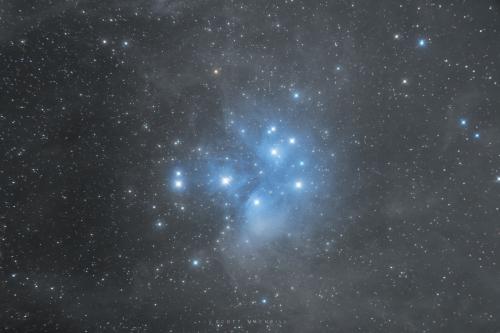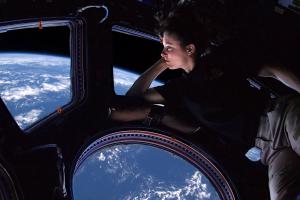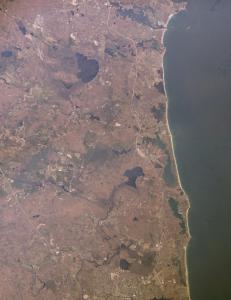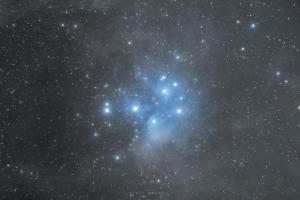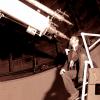Celebration of Space - February 4, 2022
On the James Webb Space Telescope (JWST) front, optical alignment of the 18 mirror segments that make up the primary telescope mirror began this past week. This allowed the JWST mission team to observe the first photons of light collected by the telescope. The process of aligning the primary mirror segments will take a period of three months. The process will happen in steps, starting with alignment and focus of each individual segment, which will produce an image of 18 copies of the star being used for alignment. During which, the telescope will be functioning as 18 separate telescopes. Once completed each segment will be aligned in a way that each of their views overlay each other, which will result in an image of only one star, overlapped or stacked 18 times. The next notable step will pair mirror segments together and measure wavelength accuracy, making adjustments to increase accuracy to smaller than a wavelength. This will allow all 18 mirror segments to work together as one large mirror, instead of 18 separate mirrors. The remaining alignment steps will increase the optical resolution of the telescope and extend the alignment to the field of view of each instrument. Over this time, many images will be collected, all of which will not be all that impressive. Though once this process is completed, the JWST will be ready to start collecting the types of images expected. For a much more in-depth description of this process, check out this NASA article on the aliment procedures.
On Wednesday, February 2, 2022, Groundhog Day occurred, marking six more weeks of winter (allegedly). Though the activity of Groundhog Day is largely just fun, it is worth noting that February 2nd is an astronomical holiday. One of the four Cross-Quarter days of the year, Groundhog Day marks the approximate midpoint between the Winter Solstice and the Vernal Equinox. Cross-quarter days are the days that fall in between the Equinoxes and Solstices. The first cross-quarter day of the year is Groundhog Day, the second is May Day, the third is Lammas in August, and the final is Halloween. Even though it’s been predicted that winter will carry on for six more weeks, we are now half way through the winter season and closing in on the start of spring.
Evening passes of the International Space Station (ISS) over our region will come to an end this week for the current viewing cycle. This doesn’t mean that the ISS will cease passes over the Northeast, it just means that all passes over our region will occur either during daytime or during a time period where the station is not in direct sunlight. Since all we see during an ISS pass is sunlight reflecting off of the station’s solar panels and labs, the station will not be visible if it’s not in direct sunlight. After this week, evening passes of the ISS will start up again on March 15, 2022. Until then, here are a few notable passes of the ISS for this coming weekend:
Fri, Feb 4 at 5:45 pm, starting in the NW, rising to 76º, heading towards the NE ← Awesome pass!
Sat, Feb 5 at 6:34 pm, starting in the W, rising to 21º heading towards the S
Sun, Feb 6 at 5:46 pm, starting in the WNW, rising to 36º, heading towards the SSE
Alongside the ISS, we also have China’s space station - Tiangong offering up some evening passes this weekend and coming week. But Tiangong will also complete evening passes this coming week, and will start up again on March 15, 2022. Here are several notable passes of Tiangong for the coming evenings:
Fri, Feb 4 at 6:02 pm, starting in the W, rising to 78º, heading towards the ESE ← Awesome pass!
Sat, Feb 5 at 6:38 pm, starting in the W, rising to 39º, and into orbital sunset
Sun, Feb 6 at 5:38 pm, starting in the W, rising to 58º heading towards the ESE ← Awesome pass!
Mon, Feb 7 at 6:15 pm, starting in the W, rising to 25º, heading towards the SSE
Note that these times are applicable for Southern New England, and are generally acceptable for the Northeast. For daily pass times of the ISS, Tiangong (Tianhe), and other bright satellites, visit the Frosty Drew Daily Satellite Pass Prediction Utility for a daily digest of bright satellite passes.
At Frosty Drew Observatory and Science Center, one of the projects our Astronomy Team is working on is a re-imaging of the Messier Catalog. The Messier Catalog is a catalog of deep sky objects (nebulae, star clusters, galaxies) that was compiled by a French astronomer named, Charles Messier, in the late 18th century. It is comprised of 110 objects, that are all visible from Northern Hemisphere locations. Among the catalog are many famous objects like the Andromeda Galaxy (M31), the Orion Nebula (M42), the Beehive Cluster (M44), and the Pleiades (M45), to name a few. Over the years there have been dozens to thousands of images captured of specific Messier objects, though a complete re-imaging of the catalog seems to remain rather obscure. NASA’s Hubble Space Telescope nearly completed this task, save some of the more obscure objects. At Frosty Drew we think this presents a fantastic public outreach opportunity, as well as a fun challenge for our imagers on the Astronomy Team. We expect to complete this task some time in late 2023. Each object in the catalog will be captured by our Astronomy Team imagers, and a vote will take place by the larger Astronomy Team for which image of each object is selected for inclusion into the final catalog. Check out this image of M45 – The Pleiades, captured this past week at Frosty Drew Observatory, which is up for vote to be included in the catalog. We will continue to post new images that are coming in as part of this project over the next several months.
- Author:
- Scott MacNeill
- Entry Date:
- Feb 4, 2022
- Published Under:
- Scott MacNeill's Columns

